The Hirajoshi Scale on Guitar
The Hirajoshi scale has a very eastern sort of sound to it. It is a more exotic scale, and is not as common as say the minor pentatonic scale, or even the harmonic minor scale. But it does have a very cool sound. If you have listened to players like Marty Friedman then you have probably heard it before.
This is going to give you a complete guide to using it. I will cover not only the theory, but a practical guide on implementing the scale, so you can use it in your improvising and playing.
It is important to remember that, like when learning anything, to start with… you will not be very good at it. It takes time for your ears and fingers to figure out how to use these scales.
But I will give you all the tips I can to speed you on the way!
Here are some video examples:
https://www.youtube.com/watch?v=FUvd2cKGPjs
Hirajoshi Scale in E minor
The Hirajoshi scale has the intervals:
1 2 b3 5 b6
Three string Hirajoshi scale examples
To get started, we are going to look at some 3 string Hirajoshi scales. We start with 3 strings because the patterns are small, and quite manageable – we can get started playing pretty quickly without having to memorise too much information.Then, after getting the hang of these smaller patterns, we can start expanding and exploring other options and bigger patterns.
Let’s start with an example, taking the Hirajoshi scale in E minor:
1 2 b3 5 b6
E F# G B C
and let’s map these notes out, in order, on the top three strings:
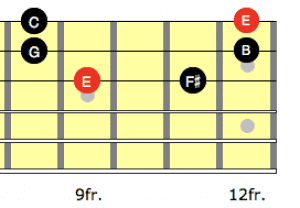
To start with, focus on just the root note and where the other notes go. Practice playing the following scale pattern up and down several times:
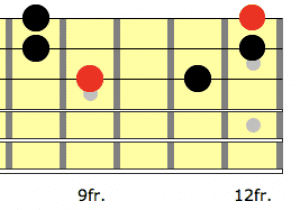
I previously wrote an article on effective ways to learn scales, so let’s apply that process to this small scale section:
- Memorise the scale pattern. Copy it out 50 times if you need to.
- Sing along to the scale.
- Play different sequences through the scale.
- Memorise where the root notes are.
- Practice playing the scale, starting on the root note.
- Improvise over some backing tracks, starting and ending on the root notes.
As we are dealing with a small section of scale, this process should be quite easy to work through. Do not skip – get busy on it before reading the next section!
Root notes on Strings 2 and 1
We are going to do the same idea, this time building 3 string Hirajoshi scales, this time with the root on the 2nd and 1st strings.
I suggest you grab a pencil and paper and try and work out the scale shapes for yourself, and then check your answer against what I got:
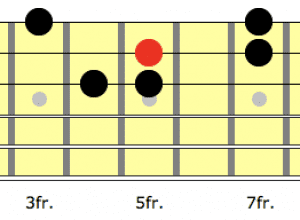
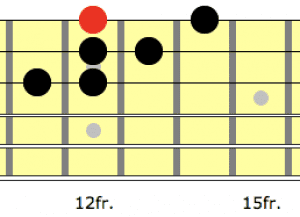
Again, repeat the 6 step process we used on the Hirajoshi Scale with a root note on the 3rd string, for the above two diagrams.
Grab that one chord backing track and have another go at improvising over the top of it
It’s important not to skip these steps!
Use all three positions at once
Next we are going to improvise over an E minor backing track (or just a single E minor chord), using all three positions. If you find it helpful, you may want to have the three scale positions infront of you – either on your computer screen or copy them out by hand so you can see them all in one place. (At the end of this article there is a downloads section where I put all the diagrams and tabs into convenient files you can download for free).
Even with the downloads I recommend drawing them out by hand – this is a great way to improve you ability to visualise and “see” fret shapes in your head.
Have a go at playing a short phrase in one position, then a short phrase in the next position, then a short phrase in the last position; and repeat. Yes, it’s going to sound messy. It will probably sound pretty crap – but that is ok!
You need to be clear in your mind about what the objective is. The objective, at this point in time, is not to create great music. It is to practice moving between scale positions by playing a phrase in each. Mastering this skill, even if it does not sound musical, is a key building block to being able to play musically.
So get started!
Changing the key of the Hirajoshi scale
Changing key on guitar is really easy. But, you do need to know where the notes are along each string. As an example, let’s say we wanted to change the key of the first shape we looked at. This scale position has the root on the third string. If we wanted to change the key of the scale from E to C, we would take the scale shape and move it horizontally, like this:

The note in red in the diagram is the ‘root note’. When you move the shape horizontally, whatever note is under the red note is now the root note, and the scale is now in the key of that note. This is why the guitar is one of the easiest instruments to change key on.
Integrating the Hirajoshi Scale with 3 String Arpeggios
When learning new scales, we want to break out of learning them in isolation as quickly as possible. This is something that took me years to realise. There are a few ways to do this and we are going to start by integrating these 3 string Hirajoshi scale positions with 3 string minor arpeggios. .You can read about some other integration exercises here.
Integrating 3rd string root minor arpeggio and Hirajoshi scale

The diagram on the left is a 3 string Hirajoshi with the root on the 3rd string. The middle diagram is a minor arpeggio with the root on the 3rd string. The diagram on the right shows how the two shapes superimposed. Drawing the diagram out for yourself may help you understand it. Take your time looking through the diagrams and make sure you understand them.
We are not aiming to play all the notes from both diagrams at once. What I want you to get from this, is the ability to see both diagrams at once, so that you can move between them. That is the take away from this section.
Here are two other integrations we can create with 3 string Hirajoshi scale and 3 string minor arpeggios:


How to practice integrating 3 string arpeggios and 3 string Hirajoshi scale
There are a couple of ways we can play around with this:
- Play up the Hirajoshi scale and down the minor arpeggio
- Play up the minor arpeggio and down the Hirajoshi scale
- Play phrases combining the two shapes together
- Repeat the above 3 steps changing the key
Here are a couple of tab examples, but WARNING: This is not the be-all and end-all of Hirajoshi scale and arpeggio integration:
-
- Play the example
- Get the hang of the example
- UNDERSTAND the example
- Compare the tab to the neck diagrams
- Figure out which note belongs to which pattern
- Understand how you are moving between the two ideas
- Most importantly – take the principle and apply it yourself to create your own examples
Here are the examples:



These small sections of scale are pretty fun. Next, let’s work on understanding the scale a bit more.
One String Hirajoshi Scales
I always like to get myself playing and doing something, before focussing on the theory. Having had a play in the scale gives my brain a reference point to tie the theory down to.
A lot of people try and learn music theory without have an audio reference… which is why they do not understand it. They can’t.
How can you explain a sound if you have never heard it? It doesn’t make any sense.
Sound is a bit like colour, in that it is ostensive – it can only be understood through individual perception.
I find that one string scales are a good starting point for conceptually understanding a scale. Having a scale laid out across a single string makes it very easy to see the different intervals that it contains.
If we take the intervals in the Hirajoshi scale:1 2 b3 5 b6
and working in the key of E, we get the notes:E F# G B C
We can map these notes out on a single string as follows:
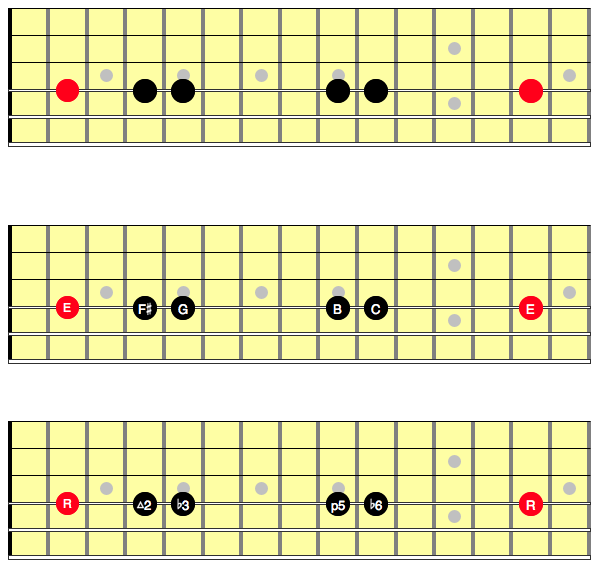
I find this approach can help for visualising the intervals, not only from the root note, but the other intervals inside the scale too. For example, you can quickly spot two intervals of a major third in the scale this way:

We can also see that the scale contains an interval of a minor third (m3):

6 String Hirajoshi Scales AKA Hirajoshi Pentatonic Scales
A common way to approach the Hirajoshi is to use it, mechanically, in a similar way to the minor pentatonic scale, breaking the scale into five different positions, containing two notes on each of the six strings. Sometimes, this is referred to as the Hirajoshi pentatonic scale.
How to work out the Hirajoshi Pentatonic Scale
It would be a great exercise for you to work these scale patterns out for yourself. Important note: Make sure you mark the root notes on the scales as you work this out. Take the 5 notes in the scale, which in the key of G are:
G A Bb D Eb
“loop” the notes round a few times (this helps for working out the next section without making mistakes):
G A Bb D Eb G A Bb D Eb G A Bb D Eb G A Bb D Eb G A Bb D Eb G A Bb D Eb
Next, place two notes on the 6th string, the next two notes on the 5th string, the next two notes on the 4th, string, etc:
String 6: G A
String 5: Bb D
String 4: Eb G
String 3: A Bb
String 2: D Eb
String 1: G A
And that will give us the 1st position for the 6 sting Hirajoshi scale.
To find the 2nd position of the Hirajoshi scale, we go back to our big string of notes:
G A Bb D Eb G A Bb D Eb G A Bb D Eb G A Bb D Eb G A Bb D Eb G A Bb D Eb
And we follow the same process, but this time, we start from the 2nd note in the string, A:
String 6: A Bb String 5: D Eb String 4: G A String 3: Bb D String 2: Eb G String 1: A Bb
To find the third position, we start from the 3rd note in the string, etc.
Hirajoshi Pentatonic scale neck diagrams
Go through this process yourself, mapping out the scale positions, and then check your answers here:





The nice thing about using a neck diagram in this way, is that it makes it VERY easy to take a shape in one key, and move it to another key.
Here are the Hirajoshi Pentatonic Scales written out in tab (to help you check your answers):





Now this is quite a lot to remember all at once. If you look at my article on how to learn scales, I would recommend that you go through that process, for each of the five patterns, one at a time. So, start off with just the first pattern, and spend a few days
- Copying out the pattern on paper (marking the root note)
- Playing the pattern up and down in different keys
- Improvising short phrases and melodies in it
- Using it over a minor backing track, in different keys
Then repeat the process for the other patterns, one at a time.
It’s important to realise that just because I can convey the information to you in a matter of minutes through words and diagrams, that does not mean you should be able to internalise that information in the same time span:
Time to read DOES NOT equal time to apply!
The above short process should take you several weeks, maybe even a month.
Integrating the Hirajoshi Scale
Knowing how to play the Hirajoshi scale and integrating it with your other skillsets on the guitar are two very different processes.
There are two different skillsets we are going to look at integrating the Hirajoshi with:
- 5 string minor arpeggios
- The minor pentatonic scale
Once we go through those areas, you will be able to integrate the Hirajoshi with any other arpeggio, 5 note, 7 note scale that you want to. The process is the same for all of them.
What does it mean to “integrate” a scale?
There are a couple of factors involved in being able to integrate a scale (or any concept) on the guitar:
- You must be able to mentally recall the two concepts simultaneously
- You must be able to mechanically move your fingers between the two ideas
- You must know a bit of theory so you can know when you can integrate different ideas
We are going to look at integrating via the root notes in the scale. Getting your mind round this is 90% of the work, and once you can integrate via the root notes, it is not a very big step to be able to integrate from any note in one idea, to any note in the other.
You can get some other examples of integrating guitar techniques here: Simple Scale and Arpeggio Integration
Integrating the Hirajoshi with 5 string minor arpeggios
Quickly recapping the 5 string minor arpeggios and staying in the key of G minor:
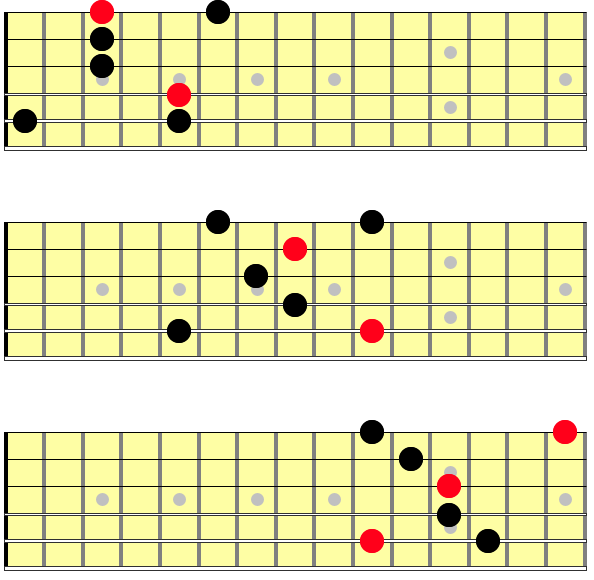
(Note: There are other shapes, but I find these are the most practical for playing)
Next we are going to look at the 5 string arpeggios that have similar notes to the 6 string Hirajoshi patterns.
If we look at the first Hirajoshi pattern and the first 5 string minor arpeggio pattern, we can see they overlap:


Hirajoshi Scale and 5 String Arpeggio Integration Exercise
You are going to:
- Play up the Hirajoshi scale and down the 5 string arpeggio
- Play up the 5 string arpeggio and down the Hirajoshi scale
- Play strings 6, 5 and 4 of the Hirajoshi scale then the top 3 strings of the minor arpeggio
- Play strings 5 and 4 of the minor arpeggio, and then the top 3 string of the Hirajoshi scale</li
(these are labelled “6 string integration 1, 6 string integration 2, etc in the GP / tab file)
Again, I will give you some tab examples, but: it is super important you take each tab example and relate it BACK to the above two diagrams. THIS is how you understand what is happening. And if you don’t understand what you are playing, then this entire exercise is worthless.
Here are the tab examples for the above exercises (Note: *** marks where the transition between Hirajoshi and arpeggio takes place):
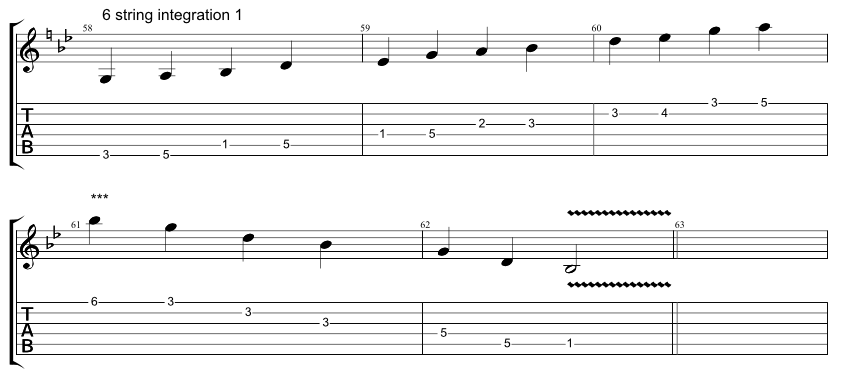
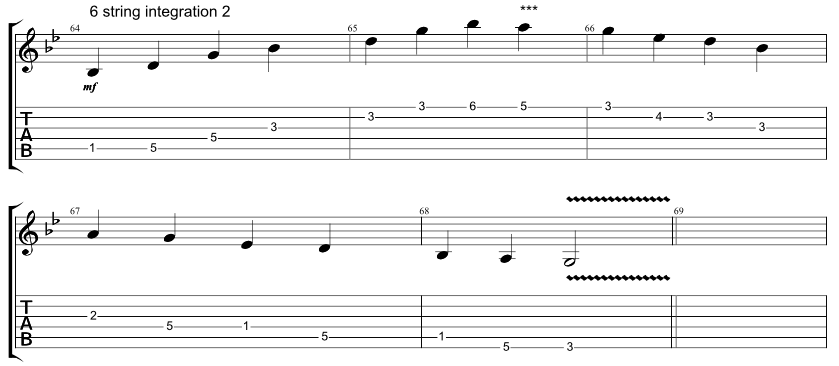
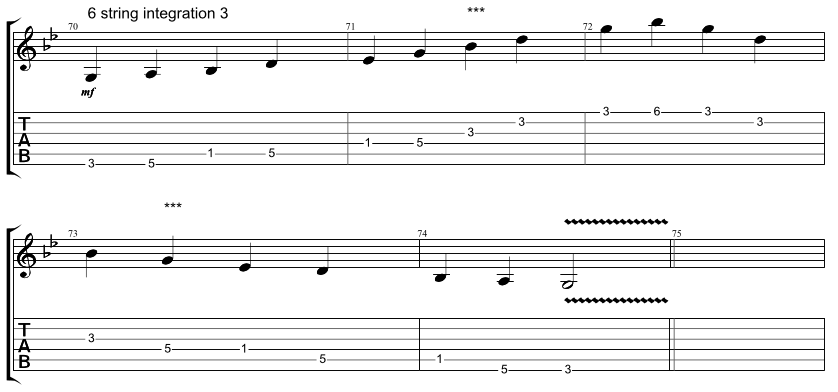
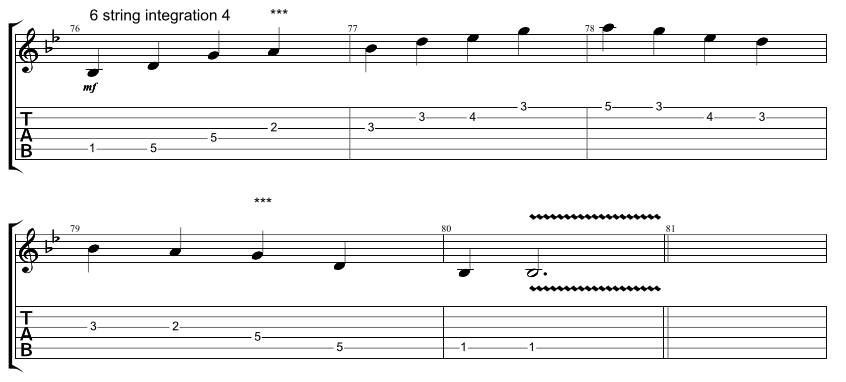
You can go through the same integration exercise with the following arpeggios and Hirajoshi scale positions:


and also these two shapes:


Once you have gone through the process outlined above, of playing up one pattern and down the other, and switching between patterns part way, have a go at putting on a backing track (or record yourself playing a G minor chord and looping it) and improvising inside those ideas.
Integrating the Hirajoshi with minor pentatonic scales
One technique that I have been having a lot of fun with, is to do some improvising in the Hirajoshi scale to build some tension, then resolve that tension with a phrase or two in the minor pentatonic scale.
To do this, you must be able to visualise the minor pentatonic and the Hirajoshi scale at the same time.
Pentatonic and Hirajoshi Scales in the Same Position
Here is the first example, showing G minor pentatonic and G Hirajoshi superimposed, so you can see how the two scales compare on the neck:
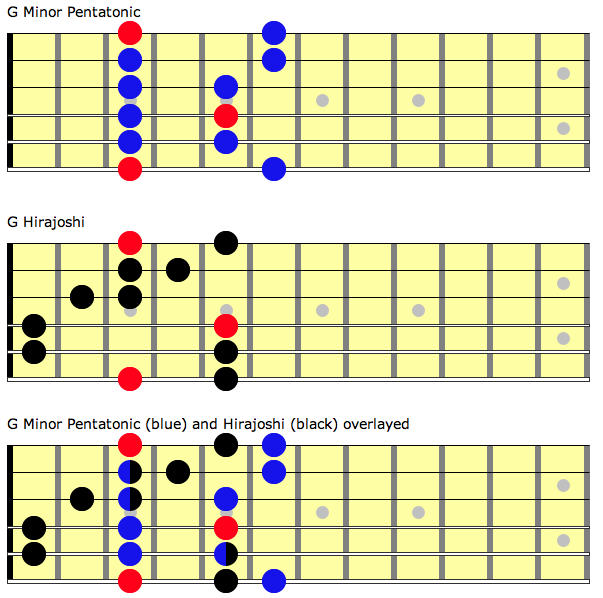
Hopefully you know your minor pentatonic scale, so you can take that, and the diagrams we already have for the Hirajoshi scale, and work out the above examples for positions 2-5 your self.
A good way to practice this, is to play up the minor pentatonic, and down the Hirajoshi, and then the reverse, up the Hirajoshi and down the minor pentatonic. Here is a tab example for the first position of both:
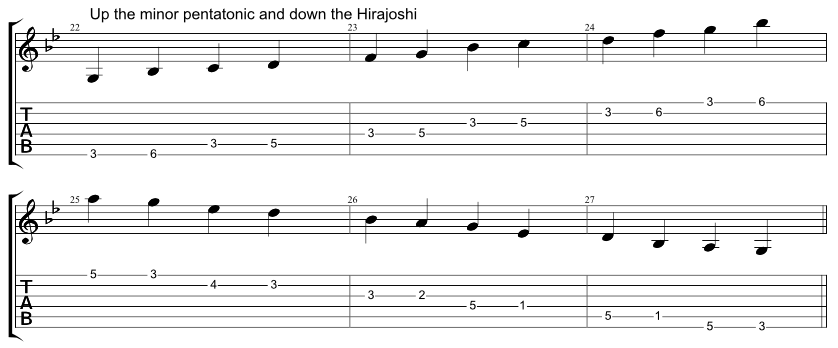 Tab showing how to play up the first position of the minor pentatonic scale, and down the first position of the Hirajoshi scale”)
Tab showing how to play up the first position of the minor pentatonic scale, and down the first position of the Hirajoshi scale”)

There are a tonne of ways you can experiment with this and I encourage you to try as many different combinations as you can. It is experiment with these combinations that will help you be able to use the scale. You should also experiment with changing the key around.
Hirajoshi and Pentatonic Scales in Different Positions
To exaggerate the difference between the two scales when improvising, as well as changing the scale we are using, we could also change the pitch range we are using. For example, we could play a phrase in the third position of the Hirajoshi, and then play a phrase in the first position of the minor pentatonic:
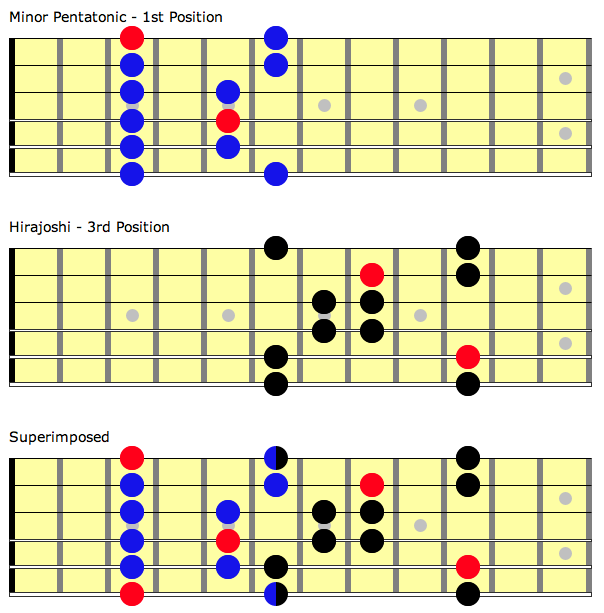
There are a tonne of ways you create variations on this idea, so start experimenting and coming up with your own examples and exercises.
3 note 2 note scale patterns
The guitar has a very symmetrical nature, which creates some interesting patterns. One such example is how symmetrical chords function on the guitar. Another is the ease at which we can transpose between chords.
Another interesting feature, is the symmetry of 3 note 2 note scale patterns on the guitar.
What are 3 note 2 note scale patterns?
Simply, we take a scale and we place four notes on the 6th string, three notes one the 5th string, and repeat that pattern across the strings as follows:
String 6: 3 notesString 5: 2 notesString 4: 3 notesString 3: 2 notesString 2: 3 notesString 1: 2 notes
Part of the value of doing this, is that we get a very symmetrical pattern that spans a large distance on the guitar neck – which is very cool for playing long scale runs!
So if we take the notes in say, G Hirajoshi:G A Bb D Eb
And map out 3 notes – 2notes, we get:

Now, in order to make this mechanically consistent for the pick, when a string has a grouping of 3 notes, I would play the third note as a slide from the second. Staying with the above example in the key of G, here is how that would look as a tab:

If we look a bit closer at the 3 note 2 note scale pattern, we can see there is a basic structure that repeats:

Another way to think about this type of scale pattern is to think of it as taking this basic scale structure as a single ‘cell’:

And play it off all the following occurrences of the root note, on alternate strings:

Which generates the 3 note – 2 note scale pattern:

We can follow the same idea, starting from the 5th string instead (and working backwards to fill in the 6th string), keeping in the key of G Hirajoshi:

And a short tab for it:

How to learn the 3note - 2 note Hirajoshi scale
Follow the same process I outlined for learning scales. Simple
Integrating 3 note – 2 note Hirajoshi scales with the minor pentatonic scale
One thing I’m a huge advocate of when it comes to learning scales on the guitar, is not to just learn scale patterns, but to be able to play scale patterns from different root notes around the guitar. This is a much more powerful way of learning scales.
This also makes integrating different ideas on the guitar much easier for you, conceptually.
If you have learned to do this with the minor pentatonic scale, then the next idea will be easy. If you have not learned your minor pentatonic scale from the root notes, you may want to put a few weeks into going over that.
If we look at the following 3 note 2 note Hirajoshi scale:

We can see that we have a root note on the 2nd string at fret 8. The third position of the minor pentatonic has a root note there:

So what we would do, is to play up the Hirajoshi from the 6th string, and at the 2nd string, transition into the minor pentatonic scale:
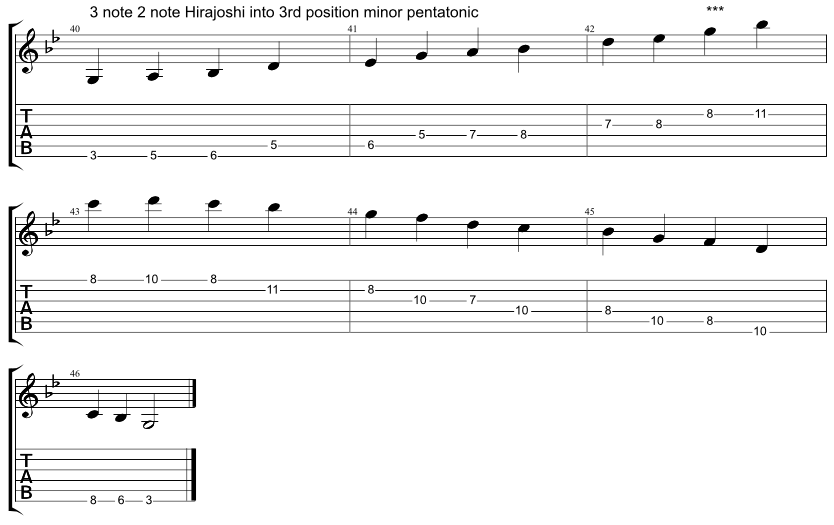
Note that *** indicates where we are transitioning from the Hirajoshi scale to the minor pentatonic scale.
When can you use the Hirajoshi Scale?
So far, we have comprehensively covered how to play the Hirajoshi scale, in terms of patterns on the neck, and how to integrate the scale with different ideas. However, it is also important to understand the musical situations where we can use the Hirajoshi scale.
In order to understand when we can use the scale, we need to look at the theory behind the scale.
Intervals in the Hirajoshi Scale
Towards the start of this lesson, we said the Hirajoshi scale contains the following intervals:
1 2 b3 5 b6
If we start thinking in terms of chords, the first thing that becomes apparent is that the Hirajoshi scale contains the same intervals as a minor chord:
Hirajoshi: 1 2 b3 5 b6
Minor chord: 1 b3 5
So, this gives us the first rule in applying the Hirajoshi scale:
Hirajoshi Scale Rule 1
Rule 1: The Hirajoshi scale can be used over a minor chord, when the root note of the chord and the scale are of the same pitch class.
Note: “Pitch class” refers to the letter of the note. For example, A is a pitch class. A on fret 5 on the 6th string is a pitch.
For example, If we were playing an E minor chord, we could play an E Hirajoshi scale over the top.
When using the Hirajoshi scale this way, all the previous integrations that we have looked at so far (minor arpeggios and minor pentatonic scales), will work.
Where else can we apply this scale?
If we look back over the diagram of the one string Hirajoshi scale, a couple of intervals jump out very quickly:

When we look at the one string Hirajoshi scale, it becomes very apparent that there are two intervals of a Major Third inside the scale. If we view the one string scale across two octaves:

(I know that guitars don’t have 27 frets, unless you have a super badass Hamer Californian Elite, but for understanding the theory, we will pretend we have this many frets. It makes visualising the theory much easier!)
We can see that we have an interval of a major third (M3) followed by an interval of a minor third (m3):

And if you are familiar with your music theory, you will notice that this is the interval construction for a major chord.
This brings us to our second rule for using the Hirajoshi Scale:
Hirajoshi Scale Rule 2
Rule 2: You can play a Hirajoshi scale over a major chord, when the Hirajoshi scale has the same root note as the major third in the major chord.
For example, if we were playing over a C major chord, we could use the E Hirajoshi scale. And it will sound badass!
Short summary of rules:
Rule 1: The Hirajoshi scale can be used over a minor chord, when the root note of the chord and the scale are of the same pitch class.
Rule 2: You can play a Hirajoshi scale over a major chord, when the Hirajoshi scale has the same root note as the major third in the major chord.
Mood and Emotion
This is the most vital theory element to the Hirajoshi scale – what does it say? What emotions and moods does this scale convey to you? Is it a tense scale or a relaxing scale? Or a combination?
If two people were talking, what sort of conversation would this scale be having? How would you respond to it? What would it be a response to?
And how does that fit in musically?
When it comes to playing guitar, it is very easy to get lost in playing patterns up and down the neck. But, we need to remember, that we learn this stuff not for the sake of it, but to become better musicians, a part of which is, being able to accurately convey emotion and story through music.
What story will the Hirajoshi help you tell?